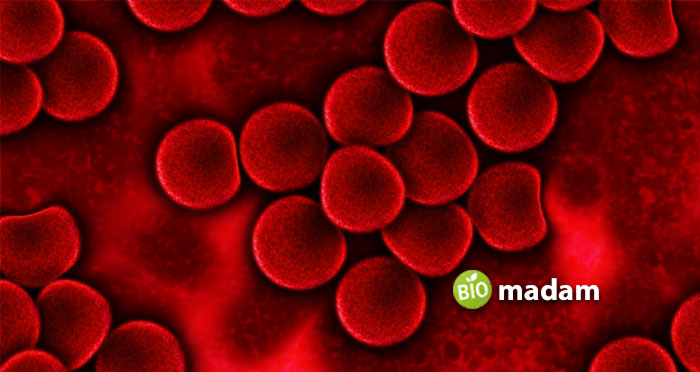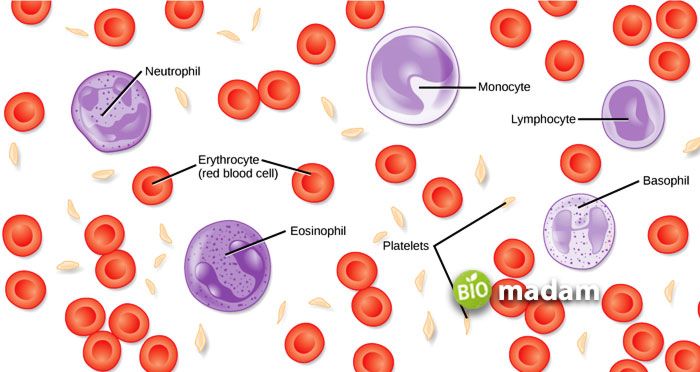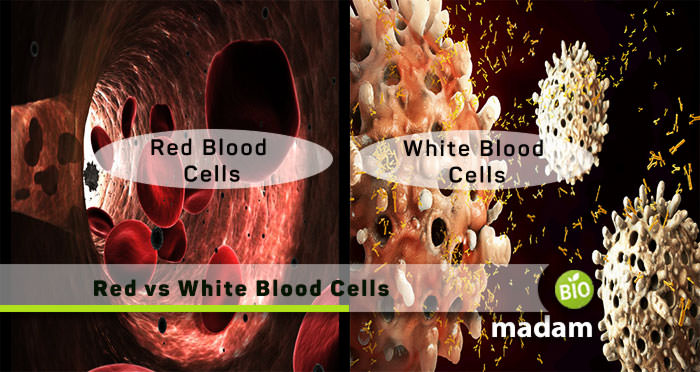The human body comprises several essential components, with a major one as blood. This vital part carries chemicals and nutrients throughout the body. Blood, on the whole, consists of different substances, all responsible for carrying out a specific task. Experts divided these substances into blood cells (where red and white blood cells are in colossal quantity) and plasma.
RBCs and WBCs correspond to 45% of the blood, whereas plasma makes up 55% of the blood. We will comprehensively discuss the differences between red blood cells and white blood cells to analyze the variations in their structure, function, types (if any), and life span. Below is a brief comparison chart between the two for your quick understanding.
Comparison Chart
| Parameters | Red Blood Cells | White Blood Cells |
|---|---|---|
| Alternative Name | Erythrocytes | Leukocytes |
| Life Span | 120 days | 13-20 days |
| Shape | Round & biconcave | Irregular |
| Primary Function | O2 & CO2 transportation | Fighting against microbes |
| Types | None | Five Types |
| Nucleus | Absent | Present |
| Blood Count (per microliter) | Approx. 5 million | Approx. 4500-11,000 |
| Transportation | Through blood vessels | From blood vessels to tissues |
What are Red Blood Cells?

Red blood cells are the fundamental blood components responsible for the reddish color. These are also commonly pronounced as Erythrocytes, acquiring a diameter of almost 6-micron meters. Red Blood Cells play a crucial role in transporting oxygen from the lungs to all tissues by storing hemoglobin.
You might wonder what this hemoglobin is. It is an RBC protein that can keep oxygen and carry it to tissues. Right at the time when it’s providing oxygen to the tissues, the cells have carbon dioxide from the same tissues to excrete the waste out of the body.
A single drop of blood includes millions of RBCs, and they are initially produced in one of the two types of bone marrow through several stages. A male body has 5.4 million red blood cells per microliter of blood, while a healthy female body has 4.8 million RBCs in the same blood.
Structure
These red cells are dumb-belled shaped that appear biconcave in small size. The central part of a red blood cell structure is hemoglobin (for oxygen) for transportation with no nucleus or other organelles. They are covered with a lipid membrane, additionally having proteins. Nature kept the size of RBC very small so it could easily circulate from even the thinnest veins inside a body. In a healthy human body, red blood cells are made every second, at a rate of 2 million cells per second. RBCs’ production involves glucose, amino acids, lipids, minerals, including zinc, iron, copper, and B vitamins.
Lifespan
Red blood cells appear and disappear every second. Many investigations have been done to figure out its life span. It has been found that the average life span of these cells is 120 days, after which they die. RBCs are naturally removed through the circulatory system after their death and replaced by new blood cells produced every second. People with diseases may have increased or decreased red blood cells depending upon the condition and its nature.
What are White Blood Cells?

White blood cells are typically the immune cells protecting a human body from various diseases. Although these cells make up the tiniest proportion in the blood, almost 1% regularly flows into the circulatory system to fight against harmful microbes. White blood cells primarily identify any foreign material inside the body, and defend it by producing antibodies through lymphocytes, to further give a humoral immunity response
The cells are found within the circulatory system and in the body’s tissues to help ensure the body is fully protected from all kinds of illnesses by fighting infections. A healthy human body consists of 4500 to almost 11,000 WBCs per cubic millimeter of blood. Persons suffering from any illness or disease might face a reduction in WBCs.
Types of WBCs
White blood cells are divided into the following types, depending upon their function and immunity from fighting against various microorganisms, e.g., bacteria, viruses, and germs.
- Neutrophils
- Monocytes
- Lymphocytes
- Eosinophils
- Basophils
Structure
Unlike red blood cells, white blood cell structure has a nucleus but lacks hemoglobin. The cells can produce ribonucleic acid (RNA) because of a nucleus and synthesize protein. All white blood cells are formed in the blood marrow, just like RBCs, but cannot perform mitosis. They have different structures based on the type and function of a cell. Considering their system, all white blood cells are differentiated into two major kinds. These are Granulocytes and Agranulocytes. Such cells have a unique ability to move through the bloodstream like an amoeba, where they transfer from the blood vessels to surrounding tissues, ensuring complete immunity.
Lifespan
White blood cells have a shorter life span than RBCs and disappear after 13 to 20 days in the lymphatic system.
Differences between Red and White Blood Cells
Other Names
Red Blood Cells
RBCs are also referred to as Erythrocytes.
White Blood Cells
In contrast, WBCs are also called Leukocytes.
Distinct Color
Red Blood Cells
The presence of hemoglobin structure turns the RBC color red.
White Blood Cells
These cells do not have any coloring substance, so they are colorless.
Production of Cells
Red Blood Cells
RBCs are produced through Erythropoiesis which is a part of spleen and liver functioning. Furthermore, the red blood cells in adults are made in the red bone marrow.
White Blood Cells
On the other hand, white blood cells are usually produced in the bone marrow through Leucopoiesis.
Size
Red Blood Cells
These cells are more extensive than WBCs, with a diameter ranging between 6 and 8-micron meters.
White Blood Cells
In contrast, white blood cells’ diameter ranges between 12 and 15-micron meters.
Number of Cells
Red Blood Cells
The number of cells varies in males and females. For a male, the RBC count is 4.7-6.1 million per mm3 of blood, whereas, for a female, it is 4.2 to 5.4 million per mm3 of blood.
White Blood Cells
Similarly, all healthy adults have almost 4k-11k white blood cells per mm3 of blood.
Difference in Shape
Red Blood Cells
All red blood cells are biconcave, circular, with disc-shape.
White Blood Cells
On the other hand, WBCs have a round shape. They are sometimes amoeboid or irregular too.
Primary Function
Red Blood Cells
The primary function of RBCs is to transport and exchange gases from all parts of a body, mainly oxygen and carbon dioxide.
White Blood Cells
On the contrary, white blood cells help a body maintain good immunity through different defense mechanisms.
Particular Systems of Function
Red Blood Cells
These cells are limited to the cardiovascular system.
White Blood Cells
In contrast, white blood cells circulate in the cardiovascular and lymphatic systems.
Total Blood Volume
Red Blood Cells
It typically depends on a person’s height, weight, and gender, but on average, RBCs count for a total of 40-45 percent blood volume.
White Blood Cells
Just like that, WBCs have almost one percent of total blood volume.
Deficiency
Red Blood Cells
The deficiency of red blood cells can lead to mild and even severe Anemia.
White Blood Cells
On the other hand, decreased white blood cell count can cause Leukopenia.
Conclusion
We cannot prefer one type of cell over the other as both hold great significance. These cells are integral body parts; hence, we can say that a human body cannot survive without Red and White Blood Cells. The key difference between red and white blood cells is their different structure and dissimilar functioning. Increasing or decreasing either of the two cells can highlight severe diseases, demanding proper medication.

Anna has completed her degree in Pharmacy from the University of Hawaii. She is serving as a research assistant in a pharmaceutical company. She had a great interest in writing blogs, traveling to different parts of the US, and trying delicious recipes in her spare time.

